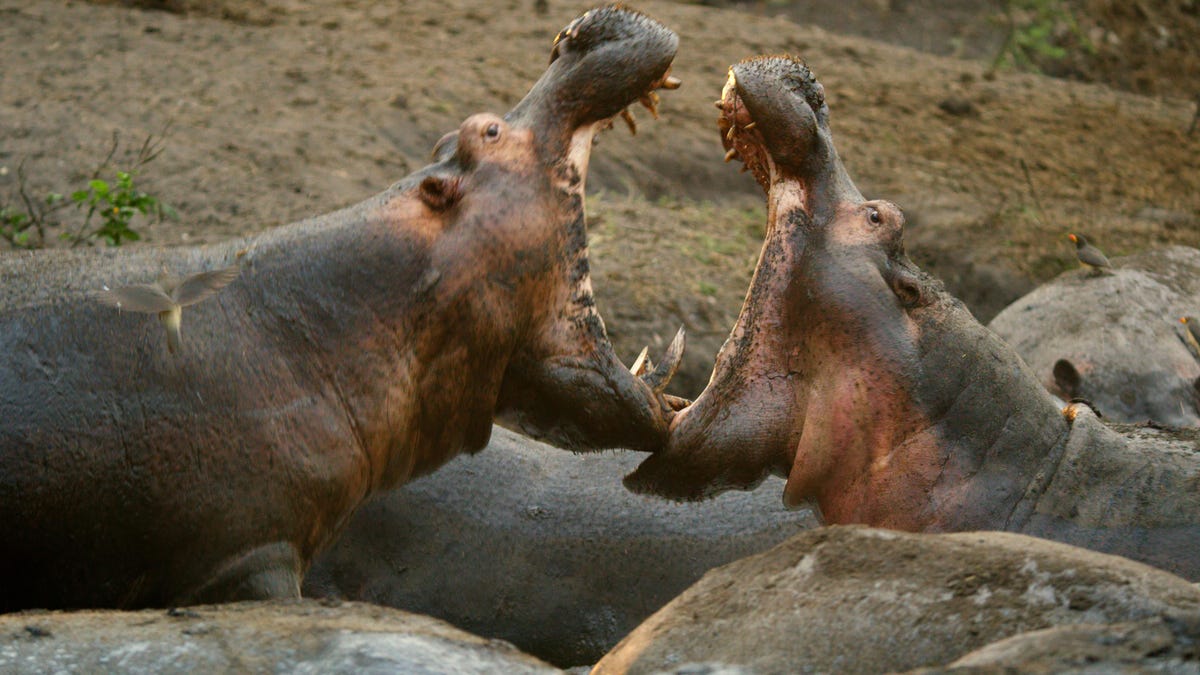Bear Grylls' new National Geographic show sees wildlife get wilder
We spoke to the intrepid Bear Grylls to find out how animals adapt and survive in the world's most extreme habitats in Nat Geo's Hostile Planet.

Overcrowded hippos fight for space in the new National Geographic series Hostile Planet.
Polar bears, turtles and spiders have more in common than you'd think. They can all survive in extreme climates and terrains.
In the new documentary series Hostile Planet -- airing on April 1 on National Geographic, also home of heartstopping hit Free Solo -- host and survivalist Bear Grylls (Man vs. Wild) takes viewers on a rare journey into some of the planet's harshest environments to see how animals adapt to unforgiving conditions.
"Hostile Planet shows the dark side of living in brutal environments," Hostile Planet host Bear Grylls told CNET. "But it also shows the light side -- where animals learn to survive."
The six-part series exhibits the toughest environments, including jungles, mountains, deserts, oceans, the Poles and grasslands. Each episode explains how wildlife survives everything from bad weather and the effects of climate change to attacks from fiercer animals.
Wildfires, blizzards, droughts and downpours often dominate these remote places where humans don't venture. Hostile Planetshot over 1,800 hours of footage, traveled to seven continents for over 1,300 days of filming to show viewers rare footage of animals hunting, fighting and battling the elements.
This isn't the kind of wildlife program where cute animals live their lives in tranquil peace. The series shows plenty of heart-stopping footage including a snow leopard and an Alpine ibex fighting in a life-or-death battle, a jaguar seizing a crocodile in its teeth and much more.
While wildlife hunting each other isn't news, Hostile Planet goes a step further in trying to capture candid moments from the animals that viewers may not have witnessed before.
Hostile Planet shows a pack of Arctic wolves in the Canadian Arctic attacking muskoxen for the first time on film.
One of the more unusual stories includes footage of an Arctic wolf pack attacking a herd of muskoxen, captured for the first time on film. A muskox weighs around 700 pounds and has razor sharp horns. So a wolf pack taking one down is no easy feat, and in the dramatic footage they end up killing not one but two muskoxen.
Hostile Planet isn't easy to watch if you find yourself rooting for cute animals who seem to find themselves in dangerous situations. In the Polar episode, I found myself crying when a young penguin was left by his pals and stranded on a piece of ice.
Just when you think he's going to swim to safety of the herd, an even bigger danger emerges. Hostile Planet is definitely not a feel-good Pixar movie experience.
"This series is powerful and sometimes heartbreaking to watch," said Grylls. "But one of these things I've learned as a survivor is to recognize in these animals an incredible survival spirit and resilience."
Cameraman David Reichert filming the Emperor Penguins march to the ice edge at the Cape Washington Emperor Penguin colony.
"When you see those baby antelope in the grasslands suddenly surrounded by hyena, you think they're all dead," Grylls continued. "Yet some of the antelope survive by working together... I appreciate their sense of family and working together that gives them strength and courage."
Heartbreak aside, the show is breathtaking to watch, featuring stunning visuals from Oscar-winning cinematographer Guillermo Navarro (Pan's Labyrinth). Also behind the camera are Emmy-nominated executive producer Martha Holmes (The Blue Planet) and Emmy-winning executive producer Tom Hugh-Jones (Planet Earth II).
Hostile Planet debuts on April 1 on National Geographic Channel.

